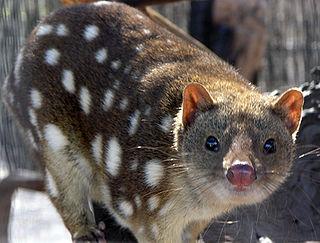
The Dasyuridae are a family of marsupials native to Australia and New Guinea, including 69 extant species divided into 21 genera. Many are small and mouse-like or shrew-like, giving some of them the name marsupial mice or marsupial shrews, but the group also includes the cat-sized quolls, as well as the Tasmanian devil. They are found in a wide range of habitats, including grassland, underground, forests, and mountains, and some species are arboreal or semiaquatic. The Dasyuridae are often called the 'marsupial carnivores', as most members of the family are insectivores.
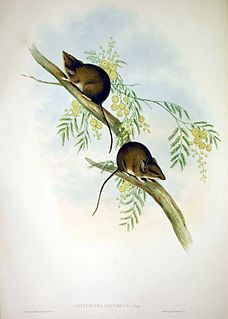
Dunnart is a common name for species of the genus Sminthopsis, narrow-footed marsupials the size of a European mouse. They have a largely insectivorous diet.

The subfamily Sminthopsinae includes several genera of small, carnivorous marsupials native to Australia: kultarrs, ningauis, dunnarts, and planigales.

Smintopsini is a tribe of marsupial in the family Dasyuridae.

The fat-tailed dunnart is a species of mouse-like marsupial of the Dasyuridae, the family that includes the little red kaluta, quolls, and the Tasmanian devil. It has an average body length of 60–90 millimeters (2.4–3.5 in) with a tail of 45–70 millimeters (1.8–2.8 in). Ear length is 14–16 millimeters (0.55–0.63 in). One of the smallest carnivorous marsupials, its weight varies between 10–20 grams (0.35–0.71 oz). The tail becomes fat a few mm from the proximal end and remains so right up to the tip. The dunnart has trichromat vision, similar to some other marsupials as well as primates but unlike most mammals which have dichromat vision. The dunnart is often eaten by other carnivores, including invasive foxes and cats, as well as other feral animals that live among its environment.

The slender-tailed dunnart, also known as the common dunnart in Australia, is a dasyurid marsupial. It has an average body length of 7 to 12 centimeters (2.8–4.7 in) with a tail length of 5.5 to 13 centimetres (2.2–5.1 in). It weighs 25–40.8 grams for males and 16.5–25.4 grams for females.

Gilbert's dunnart is a recently discovered dunnart, described in 1984. The length from snout to tail being 155–180 mm of which head to anus is 80–90 mm and tail 75–90 mm long. Hind foot size is 18 mm, ear length of 21 mm and with a weight of 14-25 grams.

The long-tailed dunnart is an Australian dunnart that, like the little long-tailed dunnart, has a tail longer than its body. It is also one of the larger dunnarts at a length from snout to tail of 260–306 mm of which head to anus is 80–96 mm and tail 180–210 mm long. Hind foot size is 18 mm, ear length of 21 mm and with a weight of 15-20 g.
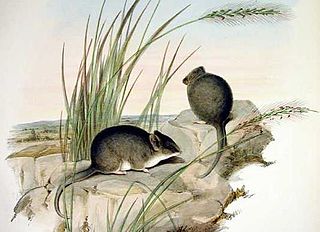
The striped-faced dunnart is a small, Australian, nocturnal, "marsupial mouse," part of the family Dasyuridae. The species' distribution occurs throughout much of inland central and northern Australia, occupying a range of arid and semi-arid habitats.

The red-cheeked dunnart is so called because of the distinctive red hair on its cheek. It is an Australasian marsupial. Its total length is 167–270 mm; its average body length is 80–135 mm with a tail of 87–135 mm. Ear length is 12–13 mm. Its weight varies between 18 and 75 grams. Its tail is thin and pale pink.

The Kakadu dunnart is a dunnart first described in 1994 and whose closest relative is the Carpentarian dunnart. It typically has a body length of 50-85mm with a tail 60-105mm long, for a total length between 110-190mm. It weighs between 10-25g, placing it in the mid-range of dunnarts. Its colour is grey, gingery on the upper body and underbelly, with white feet.

The Carpentarian dunnart also known as Butler's dunnart is a marsupial with a puffy brown or mouse grey colour above and the underside of white, similar to its close relative the Kakadu dunnart. Head to anus length is 75-88mm with a tail of 72-90mm long for a total length of 147-178mm. Weight varies from 10-20g depending on a variety of factors including sex, food abundance, habitat etc.

The Julia Creek dunnart is a marsupial with a buffy brown upperside and white underside. This dunnart has a body length of 100–135 mm with a tail of 60–105 mm to make a total length of 160–240 mm. Its weight is between 40 and 70 g. The length of the hind foot is 22–24 mm. The species has a dark brown triangle colour from above and below the eye with the point at the nose, and another dark stripe on top of the skull. A healthy dunnart has a carrot-shaped tail filled with fat stores.

The Kangaroo Island dunnart is a dark sooty-grey coloured dunnart species first described in 1969, with paler underparts of its body. It has an average body length of 170–198 mm, a snout to anus length of 80–93 mm, a tail measurement of 90–105 mm, a hind foot of 17.5 mm, ear length of 18 mm and a weight of 20–25 grams. The thin tail is also gray, but lighter on the bottom. The tail is longer than the body. Kangaroo Island dunnarts are dimorphic, with males larger than females.

The grey-bellied dunnart, alternately spelled gray-bellied dunnart, was described by the same people Kitchener, Stoddart and Henry along with the Kangaroo Island dunnart, Gilbert's dunnart and little long-tailed dunnart in 1984. They also described the Mallee ningaui in 1983.
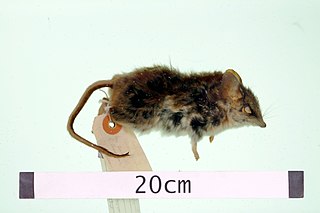
The sandhill dunnart is a species of small carnivorous Australian marsupial of the family Dasyuridae. It is known from four scattered arid areas of Australia: near Lake Amadeus in Northern Territory, the central Eyre Peninsula in South Australia, the southwestern edge of the Great Victoria Desert in Western Australia, and at Yellabinna in South Australia.
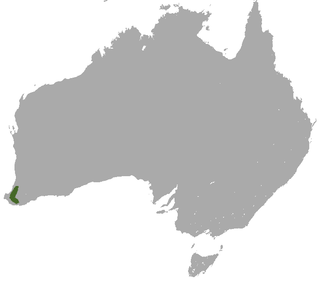
The sooty dunnart is a species of dunnart found in Western Australia. It is one of the least-known of the dunnarts, with the IUCN classifying it as data deficient. It was formerly believed to be a subspecies of the common dunnart.
Boullanger Island lies off the coast of Western Australia and covers an area of about 35 hectares. The nearest settlement is the mainland town of Jurien Bay.














